Overview
This article presents seven strategies that family wineries can implement to enhance growth through direct-to-consumer (DTC) sales. It emphasizes the critical importance of:
- Cultivating robust customer relationships
- Harnessing the power of digital marketing
- Optimizing wine club memberships
- Employing effective storytelling techniques
These strategies are designed to strengthen brand loyalty and drive sales in an increasingly competitive market. By adopting these approaches, wineries can position themselves for success in the evolving landscape of consumer engagement.
Introduction
Family wineries are navigating a transformative landscape where direct-to-consumer (DTC) strategies have become essential for growth and sustainability. The significant surge in online sales, coupled with an increasing demand for personalized experiences, positions these wineries at a pivotal crossroads. How can they effectively harness innovative marketing tactics and customer engagement to not only boost sales but also foster lasting relationships with consumers? This article explores seven impactful strategies that family wineries can implement to thrive in a competitive market, ensuring they not only meet but exceed the evolving expectations of their clientele.
Enocap: Transformative DTC Strategies for Family Wineries
Enocap stands at the forefront of developing transformative direct-to-consumer (DTC) strategies that empower family producers to forge meaningful connections with their consumers. By prioritizing the establishment of robust online sales channels and optimizing client interactions, Enocap enables wine producers to significantly enhance their market share and revenue. This strategic focus not only drives immediate sales growth but also cultivates , ensuring sustainable success in a rapidly evolving industry landscape.
Recent trends reveal that nearly 60% of vineyards anticipate an increase in their DTC sales in the coming year, reflecting a growing optimism within the sector. Creative marketing tactics aimed at younger consumers are proving successful, with establishments such as Clif Family reporting a remarkable 244% rise in sign-ups for their flexible subscription model compared to conventional wine clubs. This shift underscores the necessity for wine producers to adapt their approaches to meet the preferences of a digital-savvy audience.
Furthermore, the value of the U.S. wine direct-to-consumer sales channel reached $4.2 billion in 2021, highlighting the significant potential for growth. As establishments navigate the complexities of DTC sales, leveraging data-driven insights becomes crucial. Enocap's expertise in strategic capital planning and media placement equips vineyards with the necessary tools to enhance customer relationships and optimize their sales approaches, ultimately resulting in a more resilient business model.
In a landscape where 70% of vineyards anticipate sales growth of over 5% in the next five years, the importance of effective DTC strategies cannot be overstated. By concentrating on establishing robust relationships with customers and adapting to market trends, family-owned vineyards can thrive and secure their position in the competitive beverage sector.
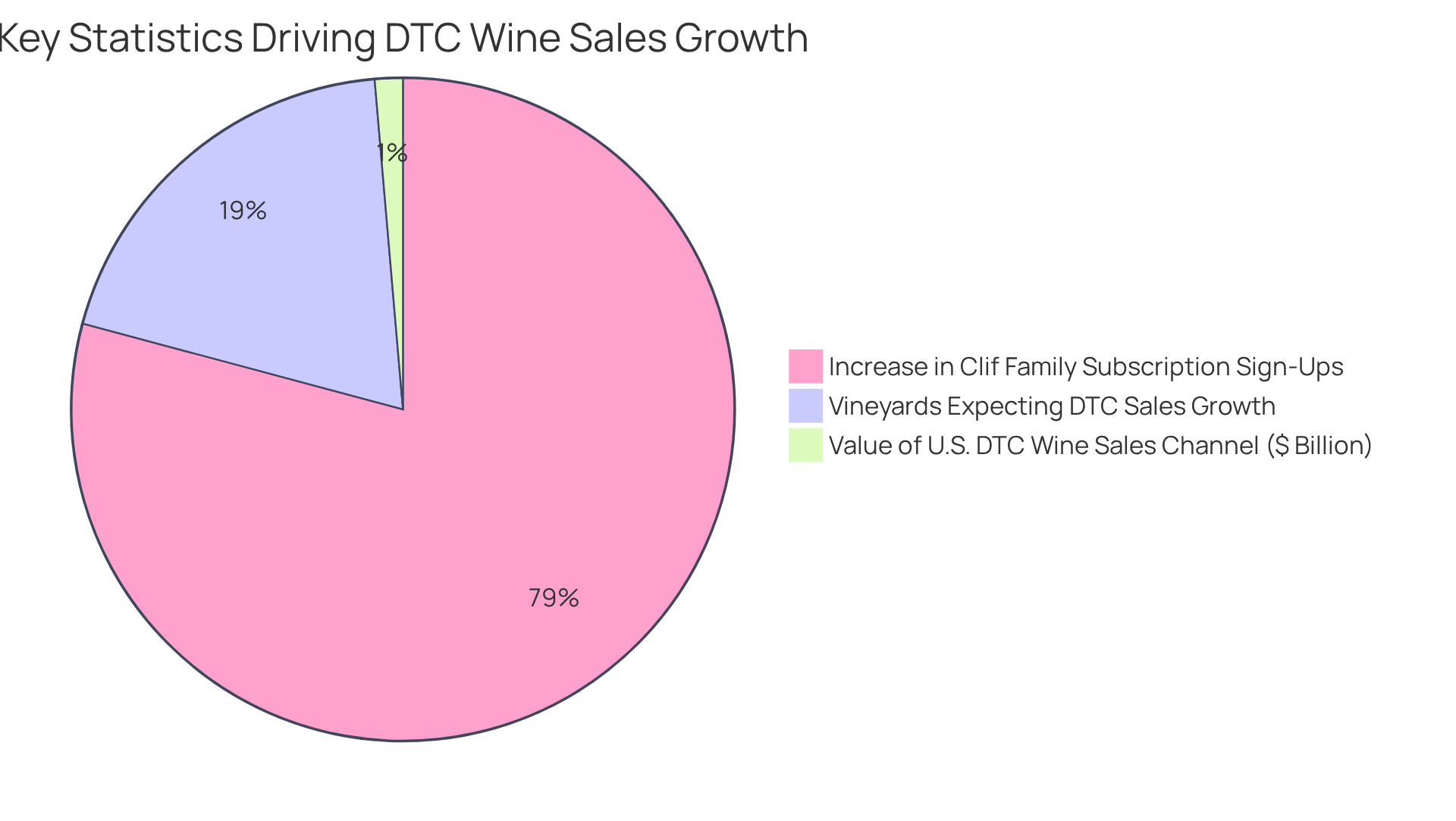
Compelling Storytelling: Building Emotional Connections with Wine Lovers
Engaging narratives are crucial for family wineries direct that aim to distinguish themselves in a competitive landscape. By articulating their rich history, core values, and the passion behind their wines, producers can create profound emotional connections with consumers. This strategy not only fosters brand loyalty but also encourages organic word-of-mouth marketing, as customers are more likely to share stories that resonate with them.
Utilizing diverse platforms, such as social media and email newsletters, allows vineyards to , reaching and engaging a wider audience. For instance, vineyards that highlight unique aspects of their production process or the personal stories of their founders cultivate a deeper appreciation among consumers.
Moreover, to transform casual buyers into dedicated club members, vineyards should implement targeted marketing strategies that showcase exclusive offers and personalized experiences. This emotional branding approach is vital in an age where authenticity and connection are essential, especially as younger generations increasingly prioritize meaningful experiences over traditional marketing methods.
To effectively apply narrative techniques, vineyards should consider sharing customer testimonials, engaging in community initiatives, and emphasizing their sustainability efforts, which resonate with contemporary consumers and support consistent growth.
Additionally, strategic capital planning is imperative for family wineries direct to secure the necessary resources for these initiatives, ensuring long-term sustainability and success.
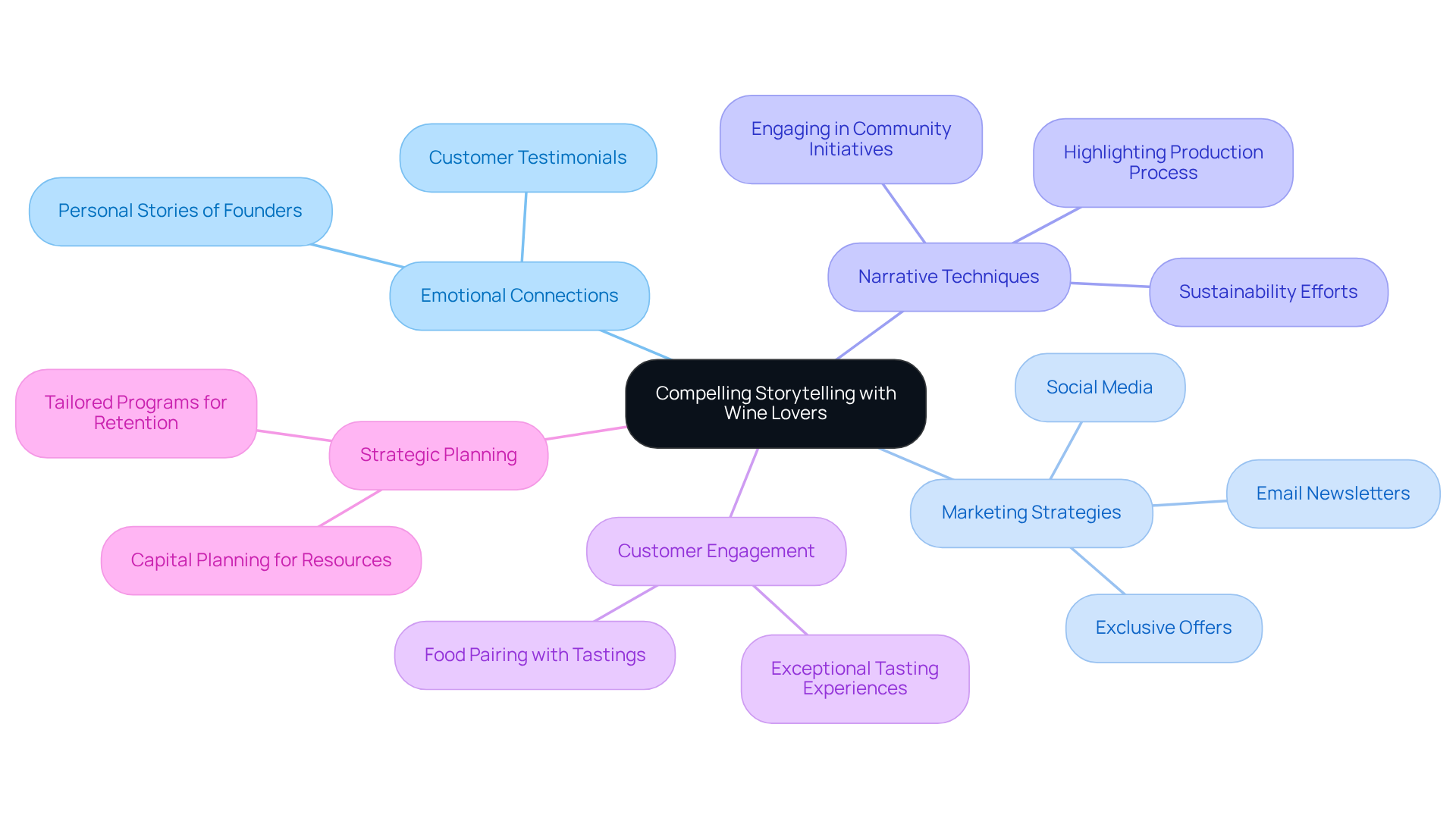
Wine Club Optimization: Enhancing Membership Value and Retention
To optimize membership in beverage clubs, family wineries direct must prioritize enhancing the perceived value of their offerings through . This can be achieved by providing:
- Exclusive access to limited-edition wines
- Personalized experiences
- Member-only events
These strategies foster a sense of exclusivity and connection. Establishing tiered membership levels and incentives that reward long-term loyalty allows establishments to cater to diverse client preferences and spending abilities, thereby creating a more inclusive environment.
Consistent communication is essential; vineyards should actively seek input from members to customize their offerings and ensure they meet evolving consumer demands. Studies indicate that customers who feel heard are twice as likely to remain loyal, underscoring the significance of engagement. Furthermore, producers should avoid over-discounting, as this can devalue their offerings and diminish retention rates. Instead, small incentives, such as complimentary bottles after a certain number of shipments, can enhance retention by rewarding loyalty and encouraging ongoing engagement.
Focusing on these transformative DTC strategies can significantly improve member satisfaction and retention, ultimately driving sustainable growth in a competitive market for family wineries direct. Notably, a 5% increase in retention can boost profits by up to 95%, highlighting the financial importance of these efforts. Enocap's strategic capital planning can further assist family vineyards in unlocking opportunities for debt, equity, or acquisitions, ensuring they flourish for generations.
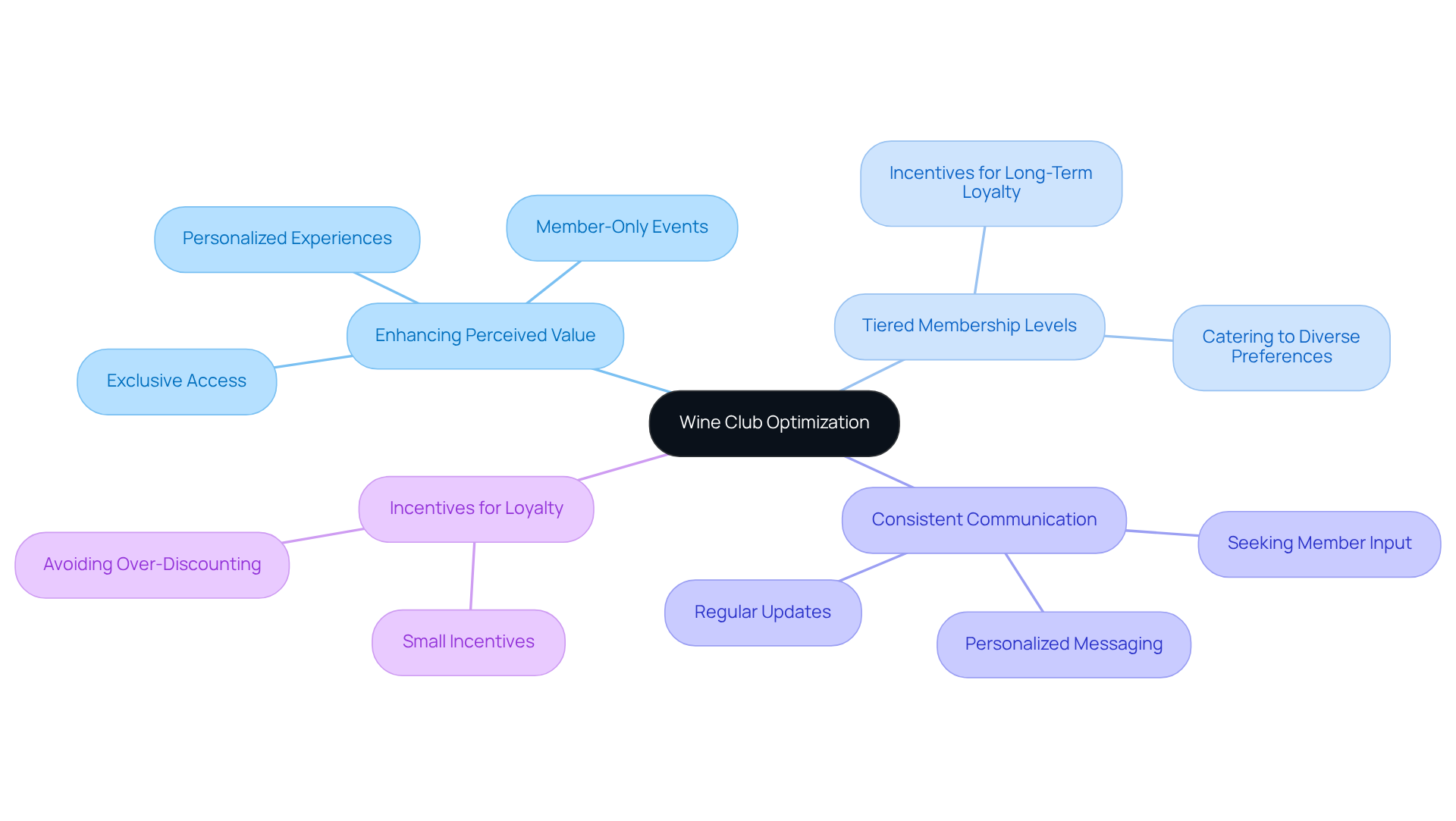
Effective Demand Generation: Attracting New Customers to Family Wineries
To effectively generate demand, family-owned vineyards must harness the power of digital marketing channels, including:
- Social media advertising
- Search engine optimization (SEO)
- Targeted email marketing campaigns
These strategies not only enhance visibility but also cultivate deeper relationships with prospective clients, transforming casual purchasers into devoted club members. Organizing captivating activities, such as wine tastings and vineyard tours, creates unforgettable experiences that significantly boost client acquisition.
Studies from the Wine Institute reveal that participants of vineyard events purchase an average of 2.5 additional bottles each year compared to non-participants. Furthermore, collaborating with local businesses and influencers can amplify this effect, generating buzz and expanding reach. For instance, influencer campaigns have demonstrated an impressive average ROI of $5.78 for every dollar spent, highlighting their effectiveness in engaging niche audiences.
By integrating these tactics with established methods for developing sustainable direct-to-consumer channels, family wineries can create a robust marketing approach that attracts new patrons and fosters steady growth.

Proven Growth Metrics: Demonstrating Success in E-Commerce for Wineries
To effectively measure e-commerce success, family wineries direct must focus on several essential performance metrics that align with innovative . Monitoring online sales volume, average order value, and client acquisition costs is paramount for understanding revenue generation. Furthermore, tracking website traffic, conversion rates, and customer retention rates provides invaluable insights into the effectiveness of marketing strategies.
For instance, establishments that enhance their online shopping experience can witness significant increases in e-commerce order volume, with some achieving an impressive 153% growth during market expansions. The global beverage e-commerce market is projected to reach USD 6.73 billion by 2025, especially for family wineries direct, highlighting the opportunity for producers to capitalize on e-commerce. Additionally, the total number of digital wine purchasers worldwide is anticipated to hit 327.8 million by 2029, underscoring the importance of efficient online strategies.
By integrating Enocap's strategic capital planning and storytelling techniques, vineyards can refine their marketing approaches and drive sustainable growth. Regular analysis of these metrics empowers vineyards to make informed decisions, enhance their marketing strategies, and ultimately improve their online presence and overall performance. By leveraging these insights, wine producers can forge stronger connections with consumers and cultivate loyalty, ensuring their success in an increasingly competitive market.
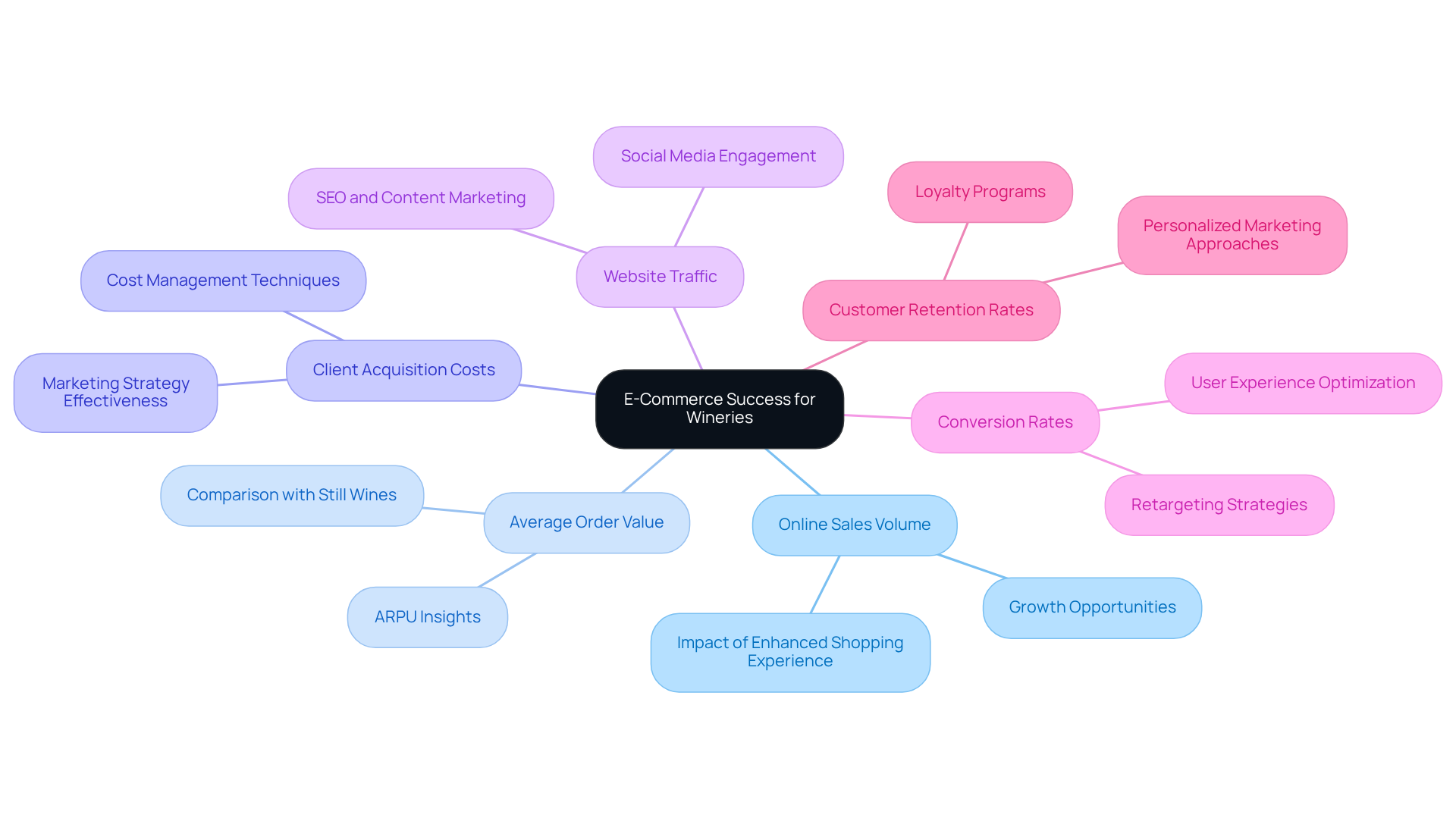
Strategic Capital Planning: Securing Funding for Family-Owned Wineries
Strategic capital planning is essential for family wineries direct that are seeking to secure financing that aligns with their growth objectives. Enocap provides comprehensive advisory services designed to unlock direct-to-consumer revenue and craft compelling brand narratives—key elements in attracting potential investors.
Various funding sources are available, including:
- Bank loans
- Private equity
- Government grants tailored specifically for agricultural businesses
In 2025, wineries stand to benefit from increased federal investment, with U.S. beverage exports exceeding $1.2 billion, bolstered by enhanced funding for export promotion programs. Creating a detailed business plan that outlines financial forecasts and growth strategies significantly improves the likelihood of obtaining funding. Additionally, maintaining transparent financial records and demonstrating a solid track record can instill confidence in potential investors or lenders.
Effective funding strategies often incorporate available grants, such as those from the USDA, which have seen funding growth from $285 million to $570 million annually, providing essential support for U.S. wine exporters competing in international markets. By implementing these strategies and leveraging Enocap's expertise in strategic capital planning, family wineries direct can adeptly navigate the complexities of funding and position themselves for sustainable growth.
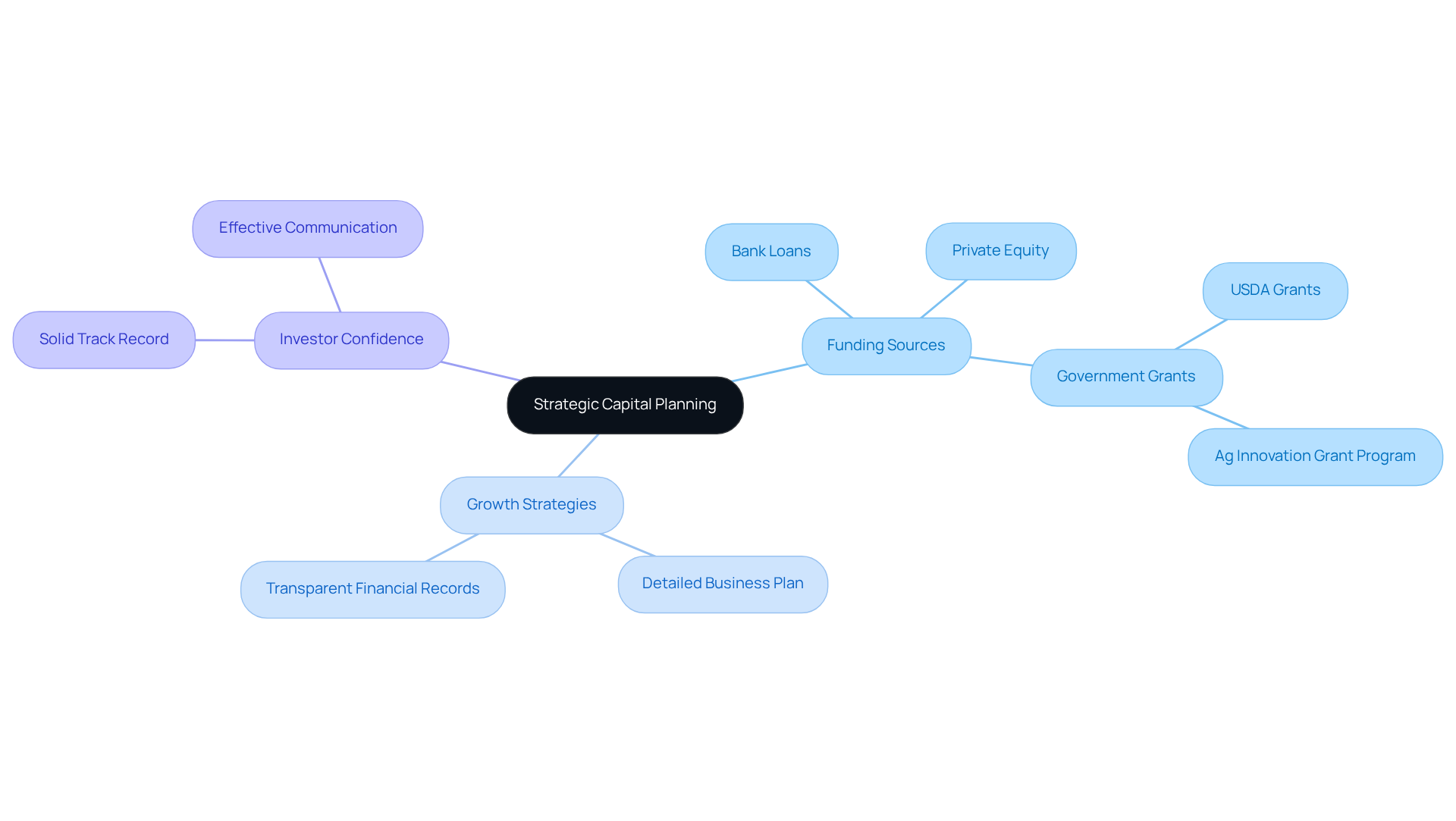
Cash Flow Management: Overcoming Financial Challenges in Family Wineries
To effectively navigate financial challenges, family-owned vineyards must adopt robust cash flow management practices that align with strategic capital planning. This process begins with accurately forecasting cash flow needs, which is essential for maintaining operational stability.
By building sustainable direct-to-consumer channels, wineries can transform casual buyers into loyal club members, driving consistent growth and enhancing cash flow. Monitoring expenses closely and optimizing inventory levels significantly reduces holding costs, ensuring resources are allocated efficiently. Establishing clear payment terms with both customers and suppliers is crucial for managing cash flow, as it helps maintain a steady inflow of funds.
Utilizing accounting software specifically designed for the wine industry can , offering real-time insights into cash flow status. This capability allows for proactive decision-making, enabling producers to modify plans as necessary.
Additionally, implementing successful financial practices, such as regular sensitivity analysis, helps businesses understand how fluctuations in revenue or expenses impact profit margins. By concentrating on these strategies, family-run vineyards can enhance their financial well-being and prepare for sustainable growth in a competitive market.
Furthermore, building resiliency in operations is vital to withstand uncontrollable market forces, ensuring long-term success.

Market Intelligence: Forecasting Sales and Adapting to Trends
Family wineries direct can significantly enhance their growth by leveraging market intelligence to analyze industry trends, consumer behavior, and competitive landscapes. By employing tools such as customer surveys, social media analytics, and sales data, family wineries direct gain valuable insights into market dynamics. Notably, around 70% of vineyards anticipate sales growth exceeding 5% over the next five years, reflecting optimism despite various obstacles. Furthermore, more than half of the vineyards surveyed plan to invest further in tasting areas and clubs to bolster direct sales for family wineries direct, underscoring proactive measures within the industry.
Adopting innovative direct-to-consumer (DTC) approaches through family wineries direct allows vineyards to forge sustainable pathways that promote steady growth and transform occasional purchasers into dedicated club members. This strategy encompasses and enhancing brand narratives to engage consumers effectively. By predicting sales through historical data and current trends, family wineries direct can make informed decisions regarding production, marketing strategies, and inventory management. This proactive stance is crucial in a rapidly evolving market, where understanding shifts in consumer preferences—such as the increasing demand for low-alcohol and health-conscious beverages, which are witnessing a surge in sales—can lead to more effective engagement strategies.
Moreover, with 27% of new club signups originating from digital channels, and demographic shifts revealing that 36% of club members are baby boomers, 30% are Gen X, 17% are millennials, and 5% are Gen Z, family wineries direct must adapt their marketing strategies to resonate with younger consumers who prioritize experiences over mere products. Enocap's strategic capital advisory services can also unlock growth opportunities through tailored debt, equity, and acquisition solutions, ensuring family-owned vineyards remain competitive. As Jon Moramarco observed, 'This shows that consumers continue to spend slightly more on wine from family wineries direct,' indicating a favorable outlook for the industry. By staying agile and responsive to these trends, family wineries direct can ensure they capitalize on emerging opportunities, even as many grape cultivators face challenges in securing buyers for their grape harvest due to canceled contracts.
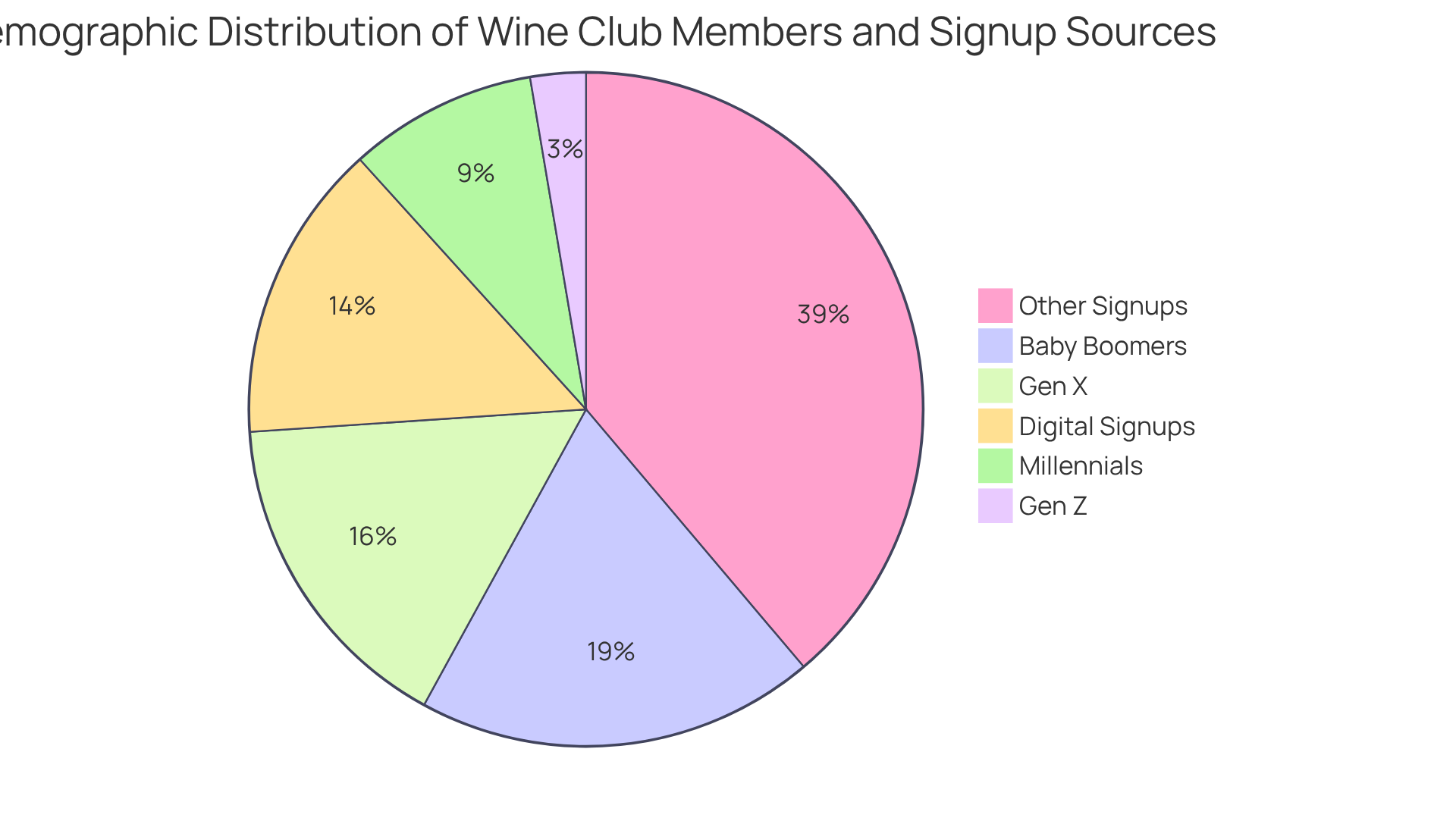
Customer Loyalty Programs: Fostering Long-Term Relationships with Wine Enthusiasts
Establishing loyalty initiatives is essential for significantly enhancing retention rates among family-owned vineyards. These programs can provide rewards such as discounts, exclusive access to events, and personalized experiences tailored to consumer preferences. By effectively converting casual purchasers into devoted club members, family wineries direct can create sustainable channels that foster consistent growth.
Regular communication with loyalty program members—through updates on new releases and special promotions—keeps them engaged and encourages repeat purchases. By cultivating a sense of community among loyal patrons, vineyards can not only elevate their brand but also stimulate invaluable word-of-mouth recommendations, which hold immense value in the competitive wine industry.
Notably, establishments that invest in loyalty initiatives frequently witness an increase in retention rates, with research indicating that enhancing client retention by just 5% can lead to profit increases ranging from 25% to 95%. This highlights the pivotal role of in driving sustainable growth and customer advocacy, while aligning with strategic capital planning for long-term success.
Furthermore, with 27% of new club signups originating through digital channels, family wineries direct can leverage digital engagement to refine their loyalty programs, further strengthening their direct-to-consumer strategies.
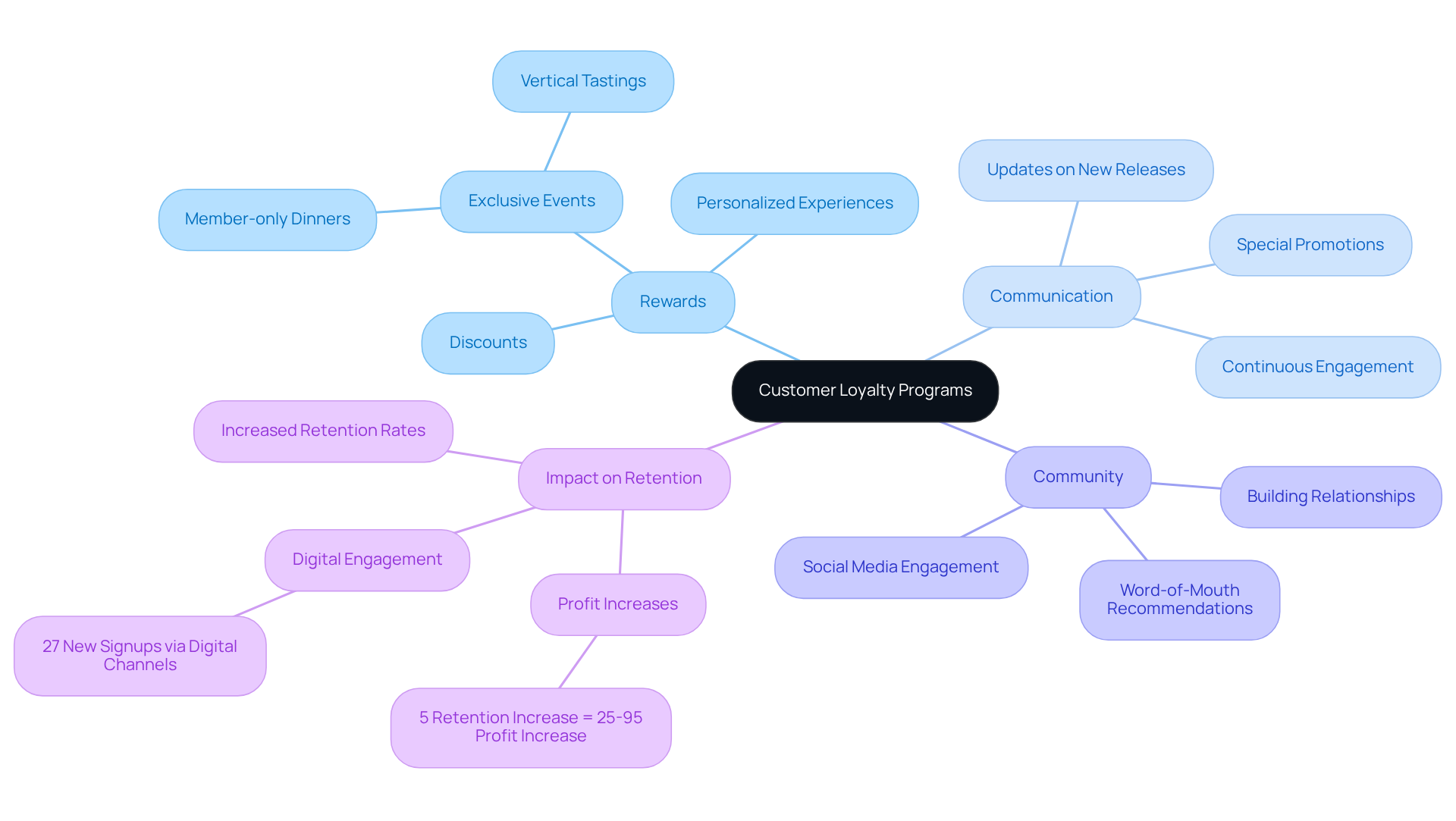
Adapting Marketing Strategies: Staying Relevant in a Changing Wine Market
To remain competitive in the evolving beverage market, family wineries direct must proactively adapt their marketing strategies by embracing . Establishing sustainable DTC channels is imperative, particularly given that 27% of new club signups now originate from digital platforms. This shift is especially significant in light of the fact that total DTC revenues in the wine sector have decreased by 3% over the past year, underscoring the challenges producers face in maintaining sales.
Social media has emerged as a vital engagement tool, with family wineries direct leveraging integrated shopping features on platforms like Instagram and Facebook to facilitate direct sales. By crafting compelling brand narratives and showcasing their natural practices and eco-friendly packaging, vineyards can resonate more with younger consumers—particularly Millennials and Gen Z—who prioritize sustainability, transparency, and unique experiences in their purchasing decisions.
Furthermore, it is essential to recognize the broader challenges confronting the industry, such as climate change events and labor shortages, which further complicate the marketing landscape. By consistently monitoring market trends and consumer feedback, wineries can refine their strategies to bolster customer retention and ensure they sustain a competitive edge in a landscape characterized by shifting consumer behaviors and preferences.
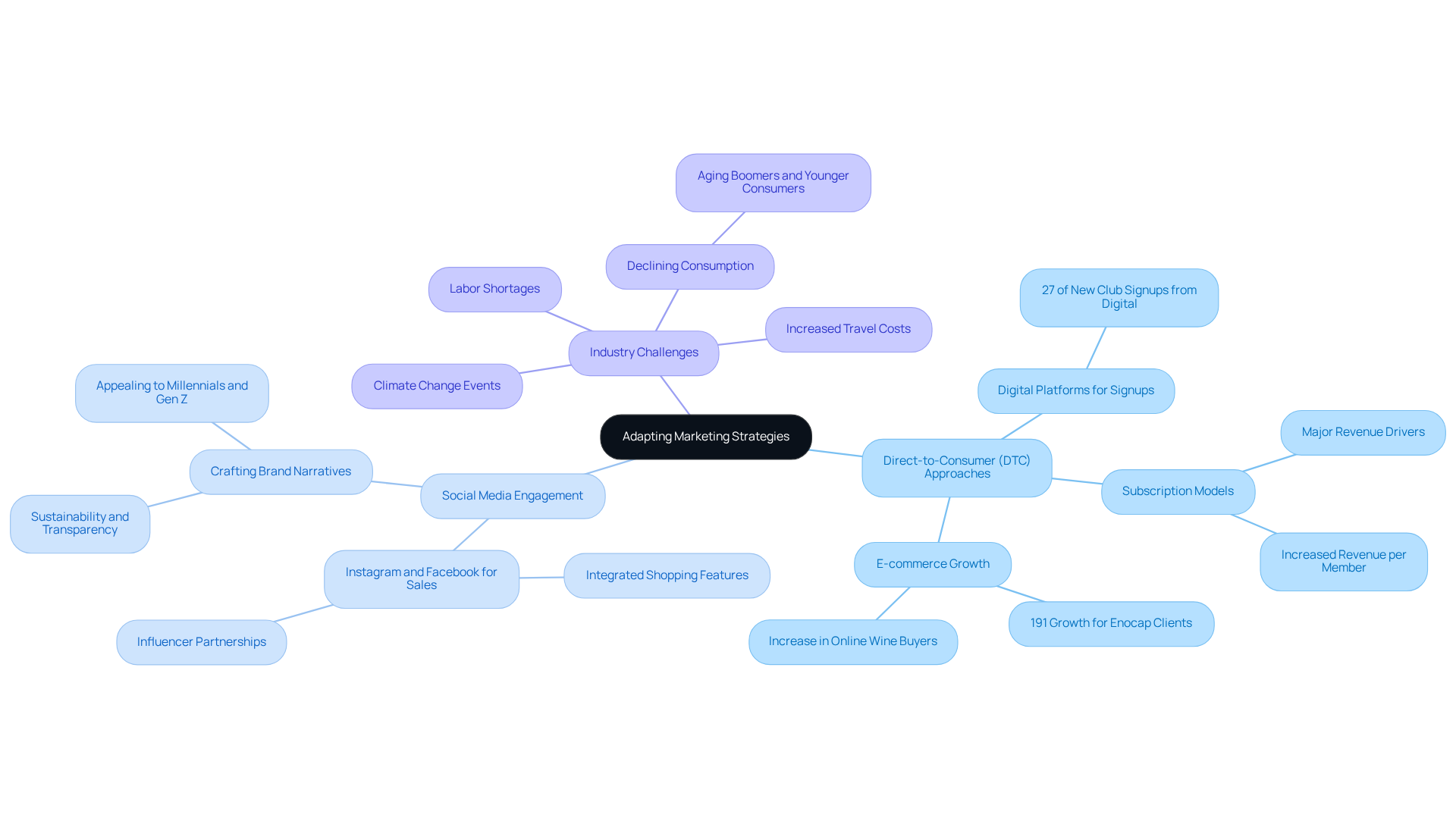
Conclusion
The strategies outlined for family wineries underscore the critical necessity of adopting transformative direct-to-consumer (DTC) approaches to foster growth and sustainability. By leveraging innovative marketing techniques, enhancing customer relationships, and optimizing membership offerings, family-owned vineyards can significantly boost their market presence while forging lasting connections with their consumers.
Key insights from the article emphasize the importance of:
- Storytelling
- Effective demand generation
- Strategic capital planning
Engaging narratives forge emotional ties with wine lovers, while targeted marketing initiatives attract new customers and convert casual buyers into loyal club members. Furthermore, grasping market trends and employing robust cash flow management practices are essential for navigating the complexities of the wine industry.
As the landscape evolves, family wineries must remain agile and responsive to shifting consumer preferences. Embracing digital marketing channels, refining loyalty programs, and maintaining a focus on sustainability will be vital for ensuring long-term success. By implementing these strategies, family wineries can not only thrive in a competitive market but also secure their legacy for future generations.
Frequently Asked Questions
What is Enocap and its role in the wine industry?
Enocap develops transformative direct-to-consumer (DTC) strategies that empower family wineries to create meaningful connections with consumers, enhance online sales channels, and optimize client interactions, ultimately increasing market share and revenue.
What recent trends are observed in DTC sales for vineyards?
Nearly 60% of vineyards expect an increase in their DTC sales in the coming year, with a notable rise in creative marketing strategies aimed at younger consumers, such as Clif Family's 244% increase in subscription sign-ups compared to traditional wine clubs.
How significant is the U.S. wine DTC sales channel?
The value of the U.S. wine direct-to-consumer sales channel reached $4.2 billion in 2021, showcasing substantial growth potential for vineyards.
What strategies can family wineries use to build emotional connections with consumers?
Family wineries can create emotional connections by sharing their rich history, core values, and the passion behind their wines, utilizing platforms like social media and email newsletters to amplify their narratives.
How can family wineries enhance the value of their wine clubs?
Wineries can optimize wine club membership by offering exclusive access to limited-edition wines, personalized experiences, and member-only events, fostering a sense of exclusivity and connection.
What is the importance of communication in wine club membership?
Consistent communication is vital as it allows wineries to seek input from members, customize offerings, and enhance member satisfaction. Engaged customers are twice as likely to remain loyal.
What is the impact of retention strategies on profitability?
A 5% increase in retention can boost profits by up to 95%, highlighting the financial importance of effective membership strategies in family wineries.
How can strategic capital planning assist family wineries?
Enocap's strategic capital planning can help family vineyards unlock opportunities for debt, equity, or acquisitions, ensuring long-term sustainability and growth in a competitive market.




